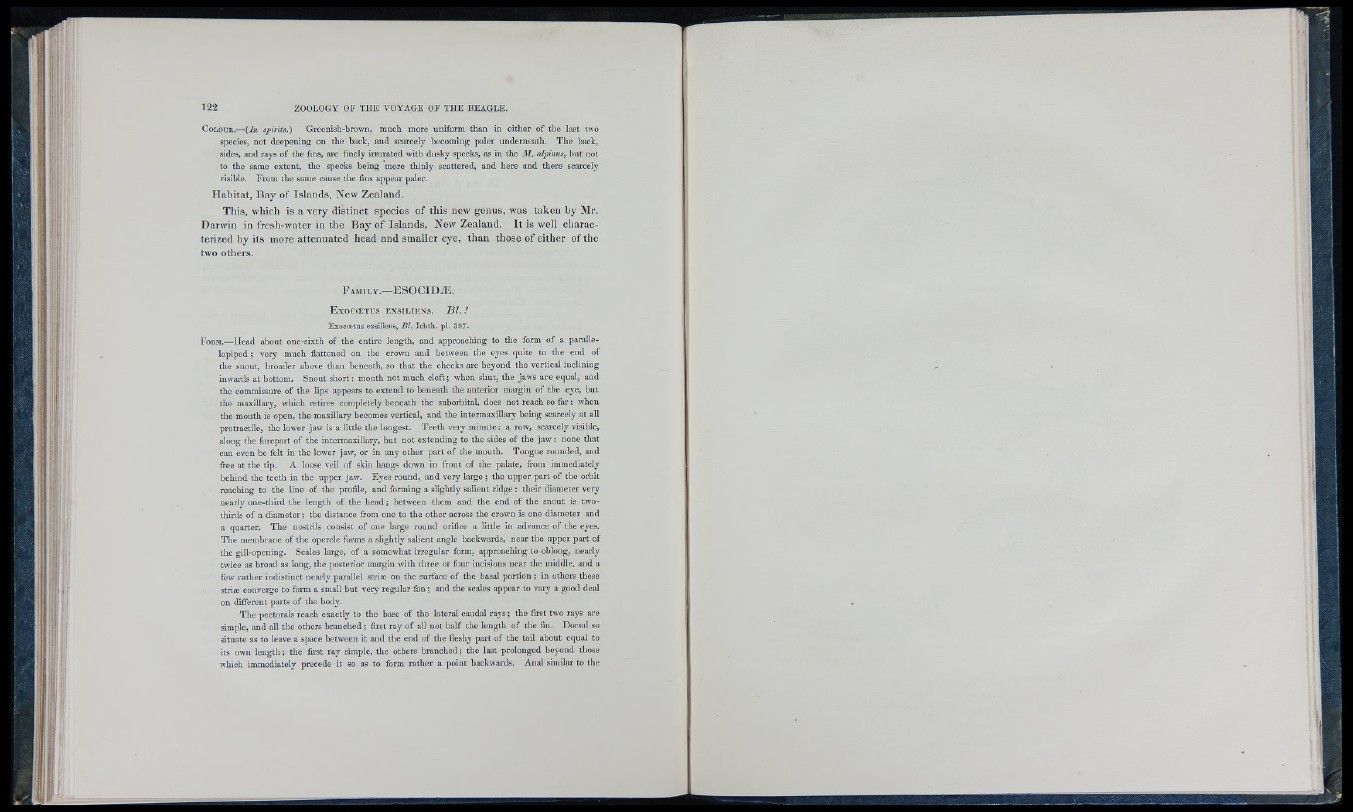
C o l o u r .— {In spirits.) Greenish-brown, much more uniform than in either of the last two
species, not deepening on the back, and scarcely becoming paler underneath. The back,
sides, and rays of the fins, are finely irrorated with dusky specks, as in the M . alpimis, but not
to tbe same extent, the specks being more thinly scattered, and here and there scarcely
visible. From tbe same cause the fins appear paler.
Habitat, Bay of Islands, New Zealand.
This, which is a very distinct species of this new genus, was taken by Mr.
Darwin in fresh-water in the Bay of Islands, New Zealand. It is well characterized
hy its more attenuated head and smaller eye, than those of either of the
two others.
F a m i l y .— E SO C ID Æ .
E x o c oe t u s e x s i l i e n s . JBl. ?
Exoccetus exsiliens, BL Ichth. pi. 397.
F o rm .— H ead about one-sixth of the entire length, and approaching to the form of i
lopiped ; very much flattened on the crown and between tbe eyes quite to the end of
the snout, broader above than beneath, so that the cheeks are beyond tbe vertical inclining
inwards at bottom. Snout short : mouth not much cleft; when shut, the jaws are equal, and
the commissure of the lips appears to extend to beneath the anterior margin of the eye, but
the maxillary, which retires completely beneath the suborbital, does not reach so far : when
the m outh is open, the maxillaiy becomes vertical, and the intermaxillary being scarcely at all
protractile, the lower jaw is a little the longest. T eeth very m inute: a row, scarcely visible,
along the forepart of the intermaxillary, but not extending to the sides of the jaw : none that
can even be felt in the lower jaw, or in any other p art of the mouth. Tongue rounded, and
free at the tip. A loose veil of skin hangs down in front of the palate, from immediately
behind the teeth in the upper jaw. Eyes round, and very large ; tbe upper part of the orbit
reaching to the line of the profile, and forming a slightly salient ridge : their diam eter very
nearly one-third the length of the h ead ; between them and the end o f the snout is two-
thirds of a diam eter; the distance from one to the other across the crown is one diam eter and
a quarter. T he nostrils consist o f one large round orifice a little in advance of the eyes.
T he membrane of the opercle forms a slightly salient angle backwards, near the upper part of
the gill-opening. Scales large, of a somewhat irregular form, approaching to oblong, nearly
twice as broad as long, the posterior margin with three or four incisions near the middle, and a
few rather indistinct nearly parallel striæ on the surface of the basal portion ; in others these
striæ converge to form a small but very regular fan ; and the scales appear to vary a good deal
on different parts of the body.
T he pectorals reach exactly to the base of the lateral caudal rays ; the first two rays are
simple, and all the others branched ; first ray o f all not half the length of the fin. Dorsal so
situate as to leave a space between it and the end of the fleshy part of tbe tail about equal to
its own length ; the first ray simple, the others branched ; the last prolonged beyond those
which immediately precede it so as to form rather a point backwards. A nal similar to the
t m